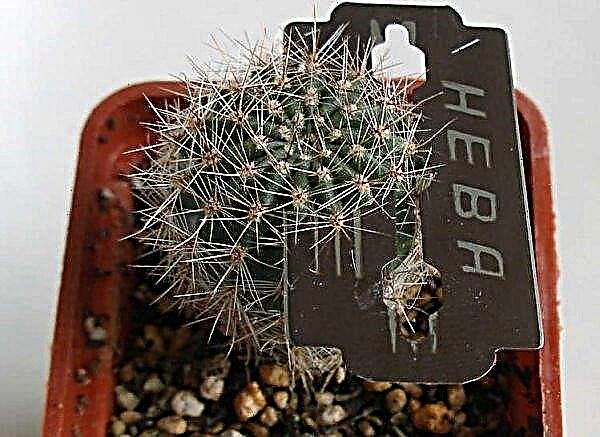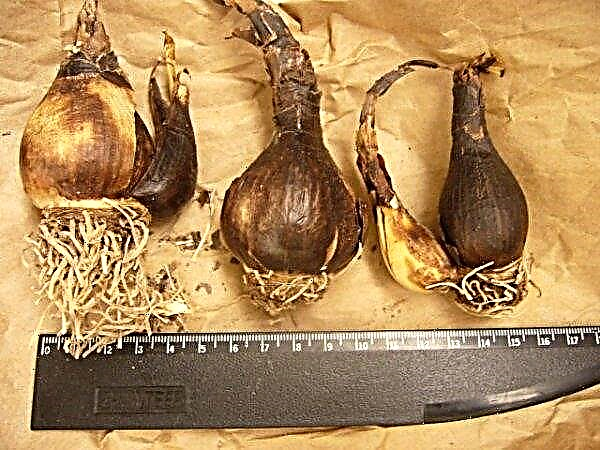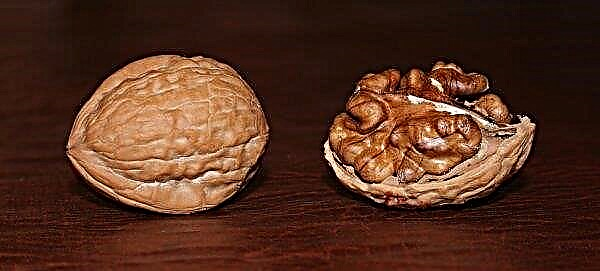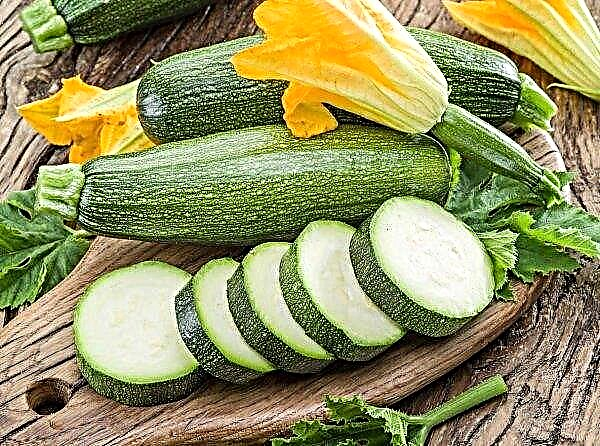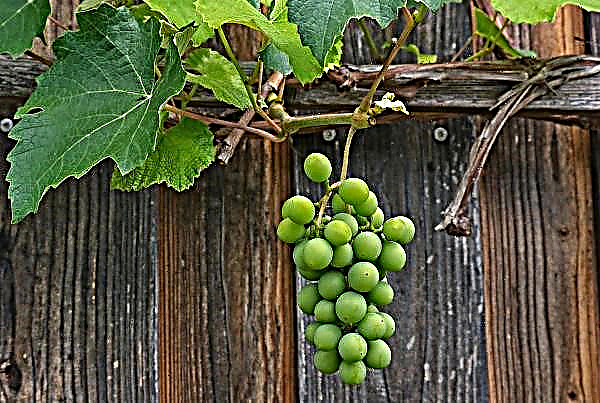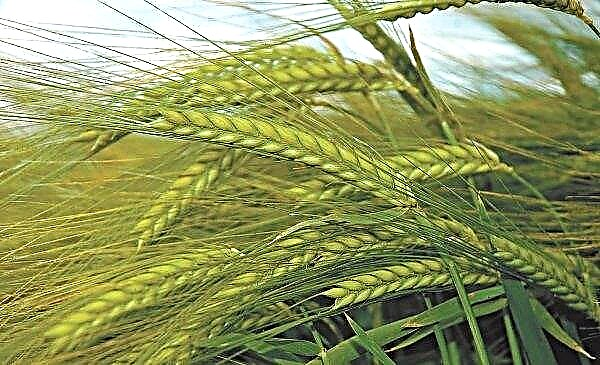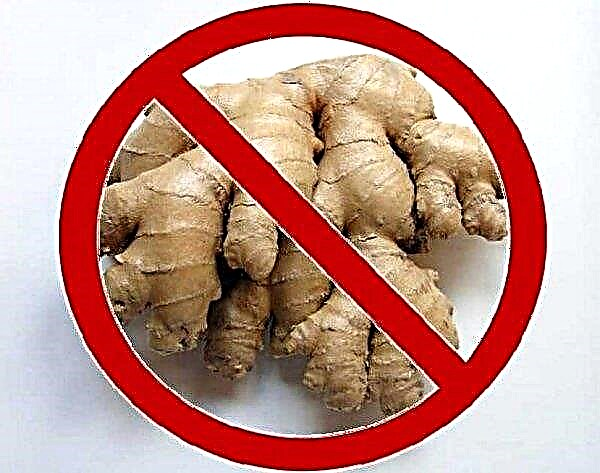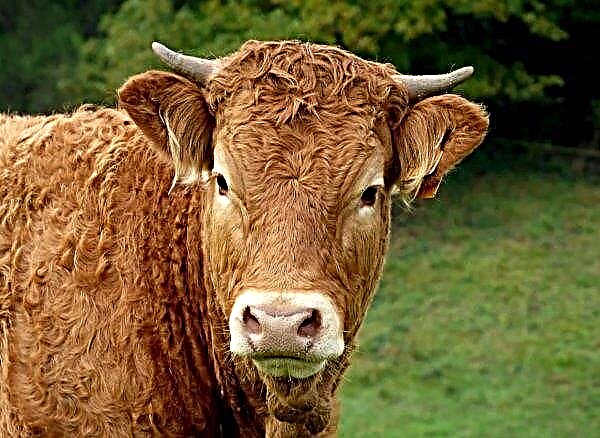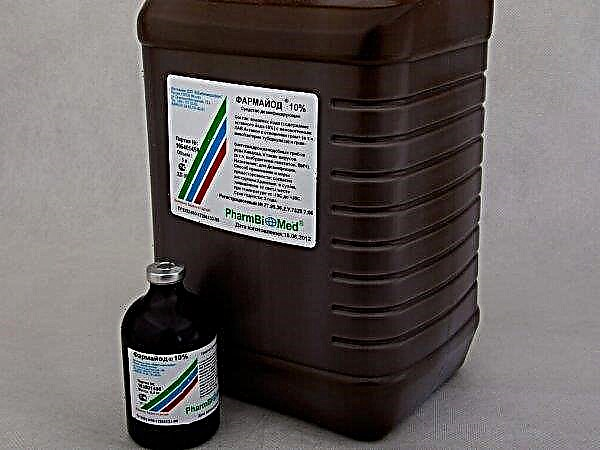Despite the many innovations among apple variety cultivars, many gardeners continue to grow "old-timers" - proven varieties that have worked well for many years. One of these is Orlinka, whose cultivation history began more than 40 years ago. The article will give an answer, what is the advantage of growing this variety and what agricultural measures are needed for this.
Botanical description of the apple tree
Orlinka is the brainchild of VNIISPK, which was named in honor of the Oryol region, where the above institution is located. Orlinka inherited his appearance and characteristics from the American form of Super Prekos and the Russian First Salute. Consider the features of the variety in more detail.
Wood appearance
Orlinka grows rapidly, reaching a height of 7-8 m. The tree is characterized by a saturated, oval crown and compact branches extending from the trunk at an acute angle. The leaves are large, rounded in shape, with a twisted top.
 Orlinka apple tree is characterized by high productivity
Orlinka apple tree is characterized by high productivity
Fruit Description
The weight of the fruits of a perfectly round shape varies from 100 to 210 g, and the main color varies from greenish yellow to yellow in consumer ripeness. Red stripes act as a cover color. After tasting the apples, their wide popularity and taste rating of 4.3 (on a five-point scale) becomes clear.
Did you know? Apple seeds contain a lot of rare vitamin B17 (letril), but you should not eat them in large quantities. Excess vitamin leads to the accumulation of poisonous hydrocyanic acid in the body. For the same reason, apples with pits are generally prohibited for children.
Orlinka Pulp:
- juicy
- tender;
- crispy
- sweet and sour;
- with a light aroma of pear candies.
 From the beginning of fruiting, Orlinka apples are quite large
From the beginning of fruiting, Orlinka apples are quite large
Pros and cons of the variety
No wonder Orlinka is one of the most famous varieties of apples.
- This is facilitated by:
- excellent taste;
- early maturity (the apple tree begins to bear fruit already at 4-5 years after planting);
- resistance to temperature extremes, frost and drought;
- high yield (up to 100 kg of apples can be removed from one adult tree per season);
- high resistance to scab.
- Among the disadvantages of the variety:
- non-maturing;
- deterioration in the taste of fruits in case of late collection;
- short shelf life.
Apple pollinators
it self-fertile grade with very abundant, fragrant flowering, attracting many insects, and therefore not requiring additional tricks for pollination. Moreover, Orlinka is an effective pollinator of other varieties.
Video: Orlinka apple tree
Frost resistance
He calmly endures the winters of the middle zone, as well as the Urals and the south-west of the Perm Territory, withstanding frosts down to –35 ° С.
Variety resistance to diseases
It is highly resistant to the five virulent scab races. May be infected with black cancer, powdery mildew, and moniliosis.
Did you know? They prefer to use apple wood for smoking, since it does not contain soot-forming resins.
Rules and landing technology
To obtain high-quality crops, you must carefully approach the issue of planting. First of all, you need to choose the right planting material and the future place of growth of the tree.
The apple tree should receive enough sunlight and heat.Therefore, for planting it is better to choose a well-lit, south or southeast side of the site. The type of soil is also important: it is supposed to be fertile, light, water and breathable, and not too acidic (pH 6-7). The groundwater level should be at least 2-2.5 m.

To be sure of the seedling belonging to the selected variety, you should purchase planting material in nurseries and specialized stores. In this case, you need to carefully inspect the seedling, paying attention to:
- color uniformity of the bark;
- lack of damage and disease;
- sufficient development of the root system (the presence of three or more branches);
- the thickness of the stem is more than 20 mm;
- the presence of at least three branches about half a meter long.
Young plants (2-3-year-olds) are chosen for planting, specifying which rootstock they were obtained. With a seed stock, fruiting will have to wait several years longer than when rooting a cuttings.
Planting dates depend on the climatic features of the region and the personal choice of the gardener. Orlinka can be planted both in spring (at the end of night frost, but before buds open), and in autumn (2-3 months before frost).
A day before planting, the roots of a seedling are immersed in water, and before direct planting, they are dipped in a talker from fertile soil, diluted with water to a creamy consistency.
Landing pit prepared in advance (at least 2 weeks, and with spring planting - in the fall). For Orlinka, they dig a hole 70–80 cm wide and three-bayonet deep in the shovel. The walls of the pit should be sheer.
Important! During planting and with further care for the apple tree, it is categorically not recommended to apply fresh manure as fertilizer. The ammonia secreted by it poisons the roots of the tree.
At the bottom lay a mixture of fertile soil, nitrogen fertilizers (nitroammophoski, urea), vegetable ash and sand. During the time remaining before planting, fertilizers are absorbed into the soil and will not damage the root system of the seedling.

The apple planting algorithm is as follows:
- A support is installed in the center of the pit (three wooden pegs about half a meter high).
- A small mound is formed at the bottom of the pit, in which a seedling is established, so that the pegs are on the side of the prevailing winds in the area.
- The root neck should be 15–20 cm from the site level, taking into account future shrinkage.
- The roots of the tree are straightened, covered with earth and slightly tamped.
- The seedling is tied to the supports (ribbons made of synthetic materials will be preferable for this).
- The tree is abundantly watered with water (3-4 buckets) and left to adapt to the new environment.

Key Care Features
Orlinka - pretty unpretentious grade and requires minimal maintenance, which includes watering, pruning, infrequent fertilizer application and frost protection (if grown in regions with severe winters).
Video: How to properly care for fruit trees
Watering
Orlinka is easier to tolerate drought than swampy soil. That's why apple should be watered moderately. The most important in the context of watering is the first year after planting: young trees are watered at least once a week. An apple tree planted in the fall is watered with settled warm water to prevent the development of diseases.
Watering seedlings using watering cans and sprinklers with low water pressure (so as not to damage the delicate root system). From the second year, the apple tree is watered if necessary, based on the condition of the earthen coma. Usually they make three obligatory irrigation per year (in spring, summer and autumn).

Pruning rules
Orlinka required annual spring and autumn sanitary pruning (removal of dry and damaged branches and leaves), and from the second year - and the forming pruning of the crown (at the same time cut off the third part of the growth), which is carried out in the spring. The entire place of the slices is treated with “Lac Balsam”, which simultaneously serves as protection against fungal diseases and accelerates tissue healing.

Fertilizers
In the first year of life, the apple tree does not need fertilizing (provided that the necessary fertilizers have been introduced into the planting pit).
In the future, the apple tree is fertilized according to the following scheme:
- When spring digging make 500 g of urea into the soil under each tree.
- During the blooming period and for mature trees during flowering make a mixture of 100 g of phosphorus fertilizer, 80 g of potassium sulfate and 50 g of urea. The mixture is pre-diluted in 20 liters of water and infused for a week.
- 2 weeks after flowering - a mixture of 50 g of nitrophoska and 1 g of sodium humate, diluted in a bucket of water (three such buckets are made under each tree).
- After harvesting - a mixture of a bucket of humus and 600 g of phosphorus-potassium complex.

Winter preparations
Preparing for the winter includes harvesting leaves and carcasses, pre-winter watering, whitewashing the stem to protect against pests.
Important! A plastic film is not suitable for protection against rodents, since mice can easily bite it.
To warm the apple tree in the cold period, the branches of the spruce tree are tied to the trunk of a tree with kapron threads or wrapped in sacking. This procedure will also protect the tree from rodents (hares, mice).
Grade Diseases and Pests
The expectation of future harvests may be overshadowed by diseases of the apple tree and the defeat of harmful insects. To prevent this from happening, you need to know about prevention methods.
As already mentioned, Orlinka has a high immunity against scab, but is susceptible to moniliosis and black cancer (fireweed), powdery mildew. In addition, the apple tree can be damaged by a variety of aphids, bugs, caterpillars.
You can protect the plant, first of all, by the correct and timely implementation of agrotechnical measures (pruning, weeding, fertilizers, watering), as well as special procedures:
- spring and autumn whitewashing of the trunk;
- spraying with herbal infusions (chamomile, elderberry);
- treatment with chemical insecticides and fungicides ("Prophylactin", "Biotlin", "Gerold", "Bordeaux liquid").

Harvesting and storage
Orlinka ripens in mid-August, but this process is uneven, apples ripen not easily, until mid-September. At the same time, you need to carefully monitor the fruits and prevent them from falling to the ground. Padanians will be tasteless and watery.
Important! Harvested crops cannot be washed and laid immediately with a large number of layers. Apples are stored in boxes at a temperature of +3 ... + 5 ° C away from potatoes and carrots.
Orlinka does not have good keeping quality and in the most ideal conditions can be stored for no more than a month. That is why these apples should be eaten fresh as soon as possible or prepared from them for the winter.

Orlinka is a variety tested over the years, whose wonderful taste, unpretentiousness in care and resistance to frost and scab are to the liking of new generations of gardeners.

